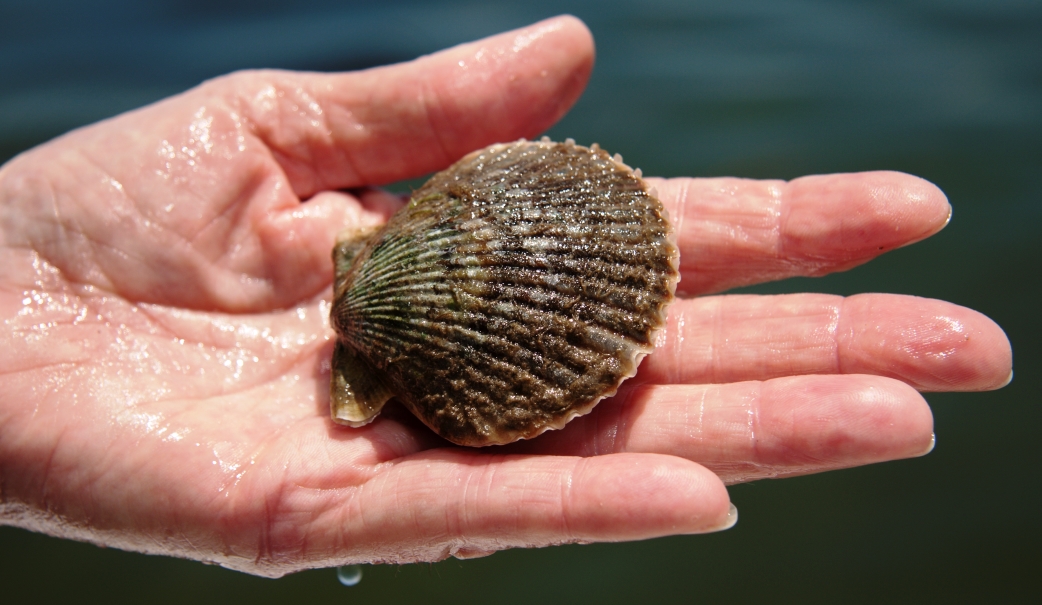It’s likely you wouldn’t be impressed by bay scallops at first glance. Surprisingly, these iconic shellfish are charismatic, with unexpected superpowers.
They can produce a jet of water to swim quickly in short-distance bursts to avoid threats from predators or to seek better growing conditions. The abductor muscle that helps the scallop “power” swim is a prized and tasty seafood delicacy.
Recreational scalloping is probably one of Florida’s most popular fisheries, especially in the Panhandle and east into the Big Bend. Some of our most-visited webpages at Florida Sea Grant and at Florida Fish and Wildlife are guides and information related to scallops. It’s amazing: these bivalves have the same level of interest as sportfish and sea turtles!
A study in 2017 estimated the economic impact of Taylor County scalloping at about $500 per day for each boat of scallopers. Trip expenditures included snorkeling supplies, fuel, lodging and food. An estimated 13,476 trips were made in the 2017 season. It’s hoped that Bay County could see similar economic benefits in the future with the restoration of recreational scalloping in St. Andrew Bay.
Through the years, Florida Fish and Wildlife Fisheries Commission (FWC) looked for opportunities to bring back scalloping to our area through sound fisheries management strategies like specifying the number you can catch each day. Unfortunately, these strategies alone haven’t worked as there are simply not enough scallops to sustain an open season at this time.
Historically, populations of bay scallops were in large numbers and able to support fisheries across many North Florida bays, including St. Andrew Bay.
Consecutive years of poor environmental conditions, habitat loss and general “bad luck” resulted in poor annual scallop production and caused the fishery to close. Bay scallops are a short-lived species growing from babies to spawning adults and dying in about a year. Populations can recover quickly when growing conditions are good and can be decimated when conditions are bad.
An opportunity to jump-start restoration of North Florida’s bay scallops came in 2011. Using funding as a result of the Deepwater Horizon oil spill, a restoration program was proposed and eventually established in 2016.
Scientists with the Florida Wildlife Research Institute (FWRI) use hatchery-reared scallops obtained from parents or broodstock from local bays to grow in mass to help increase the number of spawning adults near critical seagrass habitat. FWRI also created “Scallop Sitters,” a program where volunteers can help with restoration, in 2018 to target efforts in Gulf and Bay counties.
Scallop Sitters tend cages of 50 scallops from the summer through the end of the spawning season in December. Volunteers agree to monitor water quality and clean scallops monthly. UF/IFAS Sea Grant Extension Bay County and Gulf County partnered with FWRI in 2018 and 2019 to train new “Scallop Sitters” for St. Andrew and St. Joe bays. About 80 volunteers received 4,200 scallops in 2019.
Heavy summer rains and the resulting salinity drop from stormwater runoff negatively impacted our Scallop Sitters success in 2018 and 2019. One station I monitored this year had 32 parts per thousand (ppt) salinity in July and 8 ppt in August. For comparison, Gulf or ocean salinity is about 35 ppt. All caged scallops at this location near the DuPont Bridge died. Other volunteers encountered similar water quality problems and scallop loss across St. Andrew Bay. However, Scallop Sitters have had some survive late into the growing season each year.
We were more selective in choosing cage locations this year, setting them away from areas like stormwater drains and other potential spots impacted by stormwater. Cages in 2019 were also placed in water deeper than 4 feet. Important questions that need answers are, “Is the observed freshwater impact from rainfall and stormwater just bad luck? Are we seeing problems related to changes in weather patterns or changes in land use? Or a combination of all factors?”
Despite the challenges, Scallop Sitter volunteers continue to provide valuable information to researchers and restoration efforts, especially in the initial years of the program. Monthly water quality samples aid in developing better strategies for siting cages or other potential methods for restocking scallops. This important volunteer program for restoration for St. Andrew and St. Joe bays will continue in 2020. Apalachicola Bay will also participate.
Tentative 2020 Scallop Sitters training and scallop distribution dates are: June 12-13 in Bay, June 19-20 in Gulf, and June 26-27 in Franklin (that includes Friday morning training/afternoon pickup or Saturday morning alternative pickup). To learn more and sign-up as a Scallop Sitter volunteer in 2020, visit the sign-up sheet at MyFWC.com, or call UF/IFAS Extension Bay County at 850-248-8091. To learn more about these topics and other upcoming events, visit bay.ifas.ufl.edu/outdoors.
Photo of bay scallop by Scott Jackson.
This article by Scott Jackson (Sea Grant agent with UF/IFAS Extension Bay County in Panama City) originally appeared in the Panama City News Herald. You can reach Scott at 850-784-6105 or lsj@ufl.edu. Reprinted here by permission.

